Another View of Washington DC
February 15-17, 2008
George & Carmon Hicks
February 19, 2008
Wreath-Laying Ceremony for the Buffalo Soldiers
at Arlington National Cemetery
On February 16, 2008, a chilly Saturday morning, the 9th and 10th Horse Cavalry Association conducted a wreath-laying ceremony at the Tomb of the Unknown Soldiers at Arlington National Cemetery. This ceremony honored the black soldiers who served in the 9th and 10th Horse Cavalry Regiments and 24th and 25th Infantry Regiments. These soldiers were given the name Buffalo Soldiers by the American Indians. Units from the Buffalo Soldiers were first stationed at Fort Myer in the 1890’s and later, during the Franklin D. Roosevelt administration. Only a few of the Buffalo Soldiers who served in World War II are still living.
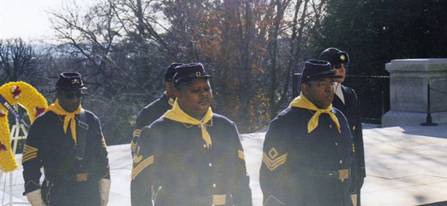
The 3rd US Infantry Regiment (The Old Guard) led the ceremony and assisted the members of the Buffalo Soldier Association. This association is a not-for-profit organization with more than 30 chapters in the U.S. with one chapter in Germany. The Washington DC chapter organized this event and other chapters supported this ceremony. We salute Arlington National Cemetery, The Old Guard, and members of the Association who gave their time and personal resources for this event.
To learn more about The Old Guard and the 9th & 10th Horse Cavalry Association visit www.buffalosoldiersresearchmuseum.org.
Reflections…
Returning to the metro Washington DC area was rewarding in a number of ways. I lived and worked there for more than 10 years and served my country as a soldier in the 3rd US Infantry (The Old Guard) at Fort Myer Company E Honor Guard. I also served in support of two US presidents at the White House Transportation Agency.
Every time I visit, I feel like I am returning home. This time, I revisited Arlington National Cemetery’s Tomb of the Unknown Soldiers and watched the Tomb guards lay a wreath in honor of the Buffalo Soldiers. Reflecting back when I was assigned to The Old Guard, I remember the Tomb quarters where the soldiers eat their meals. I enjoyed many conversations with them while they relaxed in the lounge area before their next shift - walking the matt - as the old timers called it. This area is located under the Tomb Plaza which is off limits to the general public.
For active duty and retired veterans, the Military District of Washington offers lodging at a reasonable rate. We stayed at Fort McNair. Fort Lesley J. McNair is the home of Company A, the Old Guard soldiers who wear the military uniform from the George Washington era. It is located on the point where the Potomac and Anacostia rivers join in Washington DC. It has been an Army post for more than 200 years, third only to West Point and Carlisle Barracks in length of service.
Fort McNair is an easy drive to waterfront dining and shopping. Entertainment ranges from Phillips seafood to Zanzibar nightclub. Fisherman’s wharf offers crab and other seafood year round. For world class entertainment, the Arena Stage is in the same neighborhood. To book a room at Ft. McNair or Fort Myer, contact the military lodging office in Wainwright Hall at Fort Myer – 703/696-3576 or www.fmmcmwr.com
Each trip back to DC brings back fond memories for Carmon and me. We always have so much to do and such a short time to fit in all the sites. This travel guide highlights some of our experiences. Enjoy!
African American Civil War Memorial
The African American Civil War Memorial honors black soldiers who fought for freedom during the U.S. Civil War. The Spirit of Freedom sculpture and its Wall of Honor serve as a reminder of the courageous story of the U.S. Colored Troops who helped end slavery and keep America united under one flag. The bronze sculpture portrays uniformed black soldiers and a sailor. It is situated in the center of a granite-paved plaza, encircled on three sides by the Wall of Honor. The wall lists the names of 209,145 soldiers including 7,000 white officers. The African American Civil War Memorial was authorized by Public Law 102-412 (106 Stat.2104), and approved by Congress on October 14, 1992.
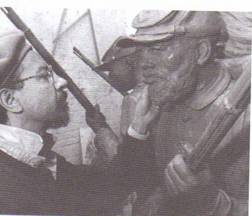
Ed Hamilton (pictured at left) is an African American sculptor who created the African American Civil War Memorial. He has sculpted a wide range of pieces honoring prominent African Americans across the country. His works include the Amistad Memorial; a monument to heavyweight boxing champion Joe Louis; a memorial honoring York, who was a vital part of the Lewis and Clark Expedition; the Booker T. Washington Memorial; and the Whitney M. Young Jr. Memorial. Hamilton was born in Cincinnati, Ohio. He grew up and currently lives in Louisville, Kentucky. We purchased a copy of his book The Birth of an Artist: A Journey of Discovery published byChicago Spectrum Press in Louisville, KY (2006). To learn more about this artist and his work, visit his website at www.edhamiltonworks.com.
The Civil War Monument is an outdoor exhibit open to the public at all times. A few blocks from the monument is a small museum located at 1200 U. Street NW Washington D.C. Museum hours are 10-5 on Monday-Friday and 10-2 on Saturday. Tours are offered by the museum on a regular basis or you can visit the museum online at www.afroamcivilwar.org. As noted in the photo, a large box of military clothing is available for youth to get into the action. We watched young Austin as he posed for photos in a Civil War uniform. The museum offers a variety of books and resources for sale. The book previously mentioned about Ed Hamilton and a three volume set that lists the names of all soldiers who served during the US Civil War are excellent resources. The Book of Names lists each soldier by state and unit so it is relatively easy to locate specific names. They also sell educational posters and prints suitable for framing.
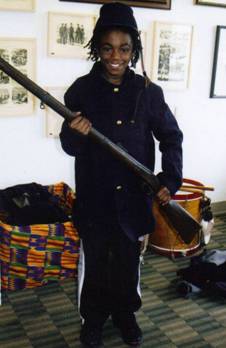
Reflections…
During the mid 1990’s, I had the time and mind-set to research the Buffalo Soldiers period (July 28, 1866 -1944). During that time, I wanted to focus on the period after the American Civil War (1861-65). Now, I am in another mind-set and have begun to focus on the Civil War. Carmon and I want to thanks the staff at the Civil War Memorial Monument for providing insight into this period and the roles that African American soldiers and sailors played in this American story. Let’s not forget the roles that women and family members contributed to the progress that was made during this historical period. If you have the opportunity to visit the Washington area-stop by the U Street neighborhood named in honor of Shaw, the white Army Captain who led the 54th Mass Regiment in the movie Glory.
The Smithsonian’s National Portrait Gallery
The National Portrait Gallery was established by an Act of Congress in 1962 and opened to the public in 1968. Its mission is to collect and display images of men and women who have made significant contributions to the history, development and culture of the people of the United States. All income from sales supports the chartered educational purposes and activities of the Smithsonian Institution.
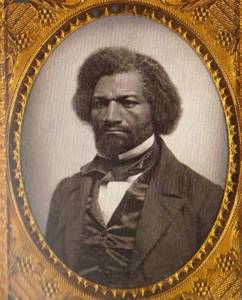
Frederick Douglass - abolitionist, 1818-1895
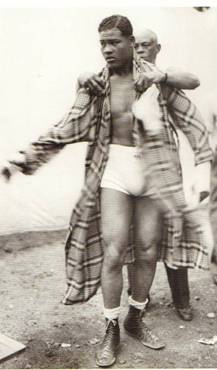
Joe Louis - boxer & WW2 Buffalo Soldier, 1914-1981
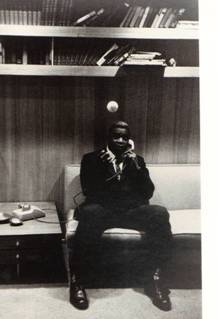
Jackie Robinson- baseball player & WW2 Buffalo Soldier,
1919-1972
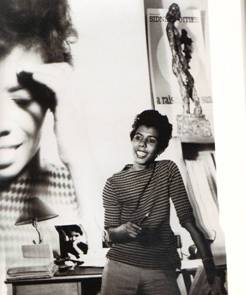
Lorraine Hansberry - playwright, A Raisin in the Sun,
1930-1965
From October 19, 2007 – March 2, 2008 - Let Your Motto Be Resistance: African American Portraits is on exhibition. It draws its name from the words of abolitionist and clergyman Henry Highland Garnet, who advocated action when speaking to a gathering of free blacks in 1843: “Strike for your lives and liberties…. Let your motto be Resistance! Resistance! RESISTANCE! . . .” The selected photographs (on the previous page) illuminate the variety of ways that African Americans resisted and redefined an America that needed but rarely accepted its black citizens.
From February 8, 2008 – October 26, 2008 - Recognize! Hip Hop and Contemporary Portraiture is on exhibition. It demonstrates the influence of hip hop on portrait artists working today. See works that stretch the idea of what a portrait is: large-scale paintings by Kehinde Wiley, black-and-white photographs by David Scheibaum, self-portrait videos by Jefferson Pinder, a poem by Nikki Giovanni, an art installation by Shinique Smith, and four 20-foot-long graffiti murals by Tim Conlon and Dave Hupp. Musical artists portrayed in the exhibition include Grandmaster Flash and the Furious Five, LL Cool J, KRSONE, Erykah Badu, and Common.
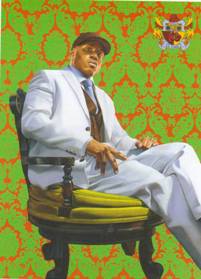
LL Cool J
Kehinde Wiley (1977-)
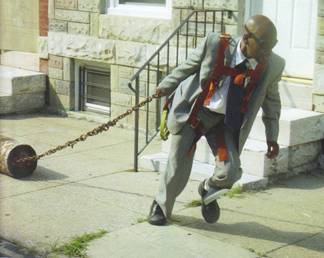
Mule, 2006 (2:32)
Jefferson Pinder (1970-)
Since its inception in the late 1970’s hip hop has become hugely influential in America. Its popularity extends beyond the urban centers of its origin and pervades youth culture throughout the world. At times controversial, hip hop has reshaped more than music. It reveals itself in various fields of endeavor-including dance, fashion, film, theatre, and art-and has inspired vigorous debates about some of the most important issues of our time.
As Nikki Giovanni relates in her poem It’s Not a Just Situation, the need and desire to express one’s individuality regardless of one’s instrument, training, or social background-has long been at the core of hip hop.
Reflections…
What a place to visit… what a museum! Being a 58-year old African American male, it was a pleasure to visit this gallery. During classroom discussions while enrolled in a graduate level museum studies program, we often focused on the black experience while visiting white museums. Security guards tend to follow us around like we may touch a painting or steal some artifact. But at the National Portrait Gallery, I felt free to look and free to think. I felt happy that I was welcomed. Carmon and I enjoyed a snack from the café before we visited the exhibits. Music was playing and the whole museum was alive. On a scale from 1-10, this place gets a 20! Check it out. No police in uniform monitoring the exhibit. Thanks - Smithsonian you got it right for us!
Nikki Giovanni was the keynote speaker at the Virginia Community College Assn. Black Concern Committee’s annually convention in 1996 and I was the committee’s chairman. I was impressed with her then and seeing/hearing her words in the hip hop exhibit connected the younger generation to mine. Her message then was to tell young people to go into the world and use their God-given talents. We can call it hip hop or whatever you want -just give our young black man the opportunity to use their creative talents. Typically, when they use their talents, we cut their efforts because we don’t understand their message. Giovanni’s poem as part of the exhibit is still preaching that same message. The difference, then and now, is that the art form for these young black men and women has crossed racial lines and even gone international.
From our perspective at the Buffalo Soldiers Research Museum, we think that this is our opportunity to communicate with the next generation. We have to tell the world about the positive contributions African Americans have played in the development of this great country - the United States of America and contributions include hip hop!
The National Portrait Gallery is located at 8th and F Streets NW, Washington DC - hours daily 11:30 a.m. – 7:00 p.m. Contact information - 202-633-1000 or www.npg.si.edu.
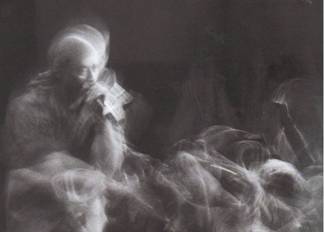
Public Enemy, Professor Griff, Sunshine Theater, Albuquerque, NM
David Scheinbaum
lens that we view the
revolution through.”
- Professor Griff Public Enemy

AREK
Tim Colon (1974-) & Dave Hupp (1973-)
It’s Not a Just Situation:
Though We Just Can’t Keep Crying About It
(For the Hip Hop Nation
That Brings Us Such Exciting Art)
Nikki Giovanni (1943- )
You don’t
Just wake up and brush your teeth and make up your bed
And put on your favorite pair of blue jeans
You don’t
On other evenings
Just sneak away from your sleeping lover
Just to grab a bite of Quik Stop
Just to stop a train
You don’t
Just visit the 24 hour superstore
Just to get a few cans
of spray paint
And
Just happen to have a case to put them in
You are not
Just out of yellow
So you’ll
Just shadow with grey this time
And
Just shy of metallic blue you will
Just fill in with electric orange
You are not
Just bored
Or hungry or silly or
Just crying for attention
You are
Just if there is a
Just
Trying to be an artist
You are
Just
If there is any
Justice
Trying to find a way of not
Just surviving but living…
You are just
Trying to show the beautiful soul of your people
You are just
Trying to say “I’m alive”
You are just
Determined to be more
Than what the powers who
Just hate the idea of you want you to be
You are just
Trying to discover the route
Of the neo underground railroad
So that your kids can
Just be free
You are just
Being a man
You are just realizing
Your womanhood
You are just singing and smiling
Because you
Just don’t want to cry anymore
You are just
Falling in love
Because hatred is too hard to bear
You are just
Determined
To be the very best you and
You just guess
You better not let anyone take that away
You are just
A person
With a big heart and wonderful talent
That you just
Think should be shared
Put a button on it
People
‘cause suspenders
Just
won’t
do.
The Jacob Lawrence Migration Series
at the Phillips Collection
The Phillips Collection, opened in 1921, is America’s first museum of modern art. Featuring a renowned permanent collection of nearly 2,500 works by American and European impressionist and modern artists, the Phillips is internationally recognized for both its incomparable art and its intimate atmosphere. Housed in founder Duncan Phillips’ 1897 Georgian Revival home and similarly scaled additions in Washington, DC’s DuPont Circle neighborhood.
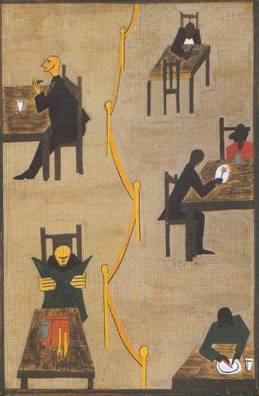
Panel 49 – They found discrimination in the North.
It was a different kind.
The Jacob Lawrence’s Migration series is a masterpiece of narrative painting portraying the movement of African Americans from the rural South to the industrial North beginning in World War I. Capturing racial rupturing of the day, Lawrence chronicles the search of a people for greater economic and social justice. Soon after its completion in 1941, the series was published in Fortune Magazine and exhibited at the Downtown Gallery in Manhattan. With this solo show, Lawrence became the first African American to be represented by a modern New York gallery. Shortly thereafter rival interest in the series resulted in its split purchase and accession by the Museum of Modern Art (who chose the even numbered panels) and the Philips Memorial Gallery (who received the remaining 30 odd numbered panels). Jacob Lawrence was only 24 when he received unprecedented interracial acclaim for the Migration series. Some 50 year later, in 1993, a reunion of the 60 artworks and a commemorative tour of the series was provided.
Reflections…
DuPont Circle is an interesting neighborhood. It was our first visit to the Phillips Collections and the exhibition of the Jacob Lawrence Migration series got us there. There were many migrations… Since I was born and raised in rural southwest Georgia and lived in the 1960’s, I remember black folks leaving the south. They were tired of picking cotton, working on the farms, and attending sub-standard schools where they got textbooks that were used the previous year at the all-white high school. I can relate to Mr. Lawrence’s series. The migration began after the Civil War when many black soldiers did not want to return to Georgia, Alabama and Mississippi. They would rather join the all-black military units later known as the Buffalo Soldiers. When I discovered their history, they touched my soul- just like Jacob Lawrence. He said in an interview in 1992 at the Phillips (on file at the museum) that the panels he painted were what he was living. For those who are visual artists, your art (photographs, painting, or poetry) is a reflection of your soul. This is the way that you express to the world what is in you heart.
The Phillips Collection
1600 21st Street, NW
Washington, DC
202-387-2151
www.phillipscollection.org.
Metro-Red Line/DuPont Circle, Q St. exit
Sources -
Brochures:
- Let Your Motto Be Resistance: African American Portraits
- The Phillips Collectiom
Books:
- Let Your Motto Be Resistance
- US Civil War Book of Names
- Jacob Lawrence and the Migration Series
Internet:
- The History of Fort McNair – Fort Myer Military Community website
